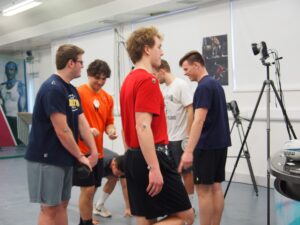Today we visited the Physiology, Biomechanics, and Performance lab at Kingston University. Dr. Hannah Moir, Senior Lecturer in Health and Exercise Prescription, provided us with an overview of sport science and the education system in the United Kingdom. I interviewed Ruby Kazemi about the events of the day.
What did you do today?
Ruby: We were split into three groups and participated in three interactive lab activities: biomechanical, environmental physiology, and physiology.

What was your favorite activity?
Ruby: I liked learning about biomechanics and the evolution of technology in this field. It is amazing how much data and statistics are now used in sports. Jona and Samantha were suited up to measure their movement on a computer when kicking a soccer ball. Then we tried out the EMG machines. The EMG machines detect the electrical potential generated by our biceps when we lifted a weight.
What was surprising to you about your day?
Ruby: I was surprised how much of the equipment they let us try out. The equipment varied in price from 100 pounds to 50,000 pounds. In the environmental physiology section, we entered a hypoxic room that simulates high altitude. Then, we visited a room that exemplifies the impact of heat on exercise. Spencer was able to run on the treadmill for five minutes and his temperature was taken before and after running. We were told about athletes who use the room to prepare to run a 220km race in the Sahara desert.
Did you notice any differences between sport science in the UK and the US?
Ruby: The culture of collegiate athletics in the UK and the US is very different. While college athletics is an important element of college culture in the US, university athletics in the UK is more like a club. Sports science in the UK is fully focused on professional athletes.

Did you learn anything that will impact how you exercise?
Ruby: I learned that ice baths are not recommended to be used after every training session. Dr. Moir explained that ice baths should be used after games or high intensity training that will last for multiple days, for example preseason training. This is information that I will use and that will hopefully improve my athletic performance.
